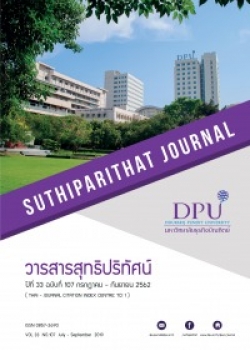กลยุทธ์การตลาดองค์รวมที่ส่งผลต่อผลสัมฤทธิ์การดำเนินงานของธุรกิจสำนักงานบัญชีในประเทศไทย
คำสำคัญ:
กลยุทธ์การตลาดองค์รวม, การตลาดสัมพันธภาพ, การตลาดเชิงบูรณาการ, การตลาดภายในองค์กร, ผลสัมฤทธิ์ธุรกิจสำนักงานบัญชีบทคัดย่อ
การวิจัยในครั้งนี้มีวัตถุประสงค์เพื่อศึกษากลยุทธ์การตลาดสัมพันธภาพกลยุทธ์การตลาดบูรณาการ กลยุทธ์การตลาดภายในที่ส่งผลต่อผลสัมฤทธิ์การดำเนินงานของธุรกิจสำนักงานบัญชีในประเทศไทย ซึ่งเป็นการวิจัยแบบผสมผสานทั้งการวิจัยเชิงปริมาณและการวิจัยเชิงคุณภาพ ตัวอย่างการวิจัยเชิงปริมาณ คือผู้บริหารสำนักงานบัญชีในประเทศไทย จำนวน 400 ราย โดยทำการเก็บรวบรวมข้อมูลด้วยแบบสอบถาม และทำการวิจัยเชิงคุณภาพด้วยวิธีการสัมภาษณ์เชิงลึกผู้บริหารสำนักงานบัญชีในประเทศไทย จำนวน 5 ราย สถิติที่ใช้ในการวิเคราะห์ข้อมูลได้แก่ สถิติเชิงพรรณนา และการวิเคราะห์สมการถดถอยพหุ (multiple regression) ผลการวิจัยพบว่า กลยุทธ์ที่มีอิทธิพลต่อผลสัมฤทธิ์การดำเนินงานของธุรกิจสำนักงานบัญชีในประเทศไทย ประกอบด้วย 3 กลยุทธ์ ได้แก่ การตลาดสัมพันธภาพ การตลาดบูรณาการ การตลาดภายใน เมื่อวิเคราะห์รูปแบบกลยุทธ์การตลาดองค์รวมที่ส่งผลต่อผลสัมฤทธิ์การดำเนินงานของธุรกิจ สำนักงานบัญชีในประเทศไทย พบว่า องค์ประกอบที่สำคัญที่สุด คือกลยุทธ์การตลาดแบบบูรณาการ กลยุทธ์การตลาดภายใน กลยุทธ์การตลาดสัมพันธภาพ ตามลำดับ
เอกสารอ้างอิง
กมล สถาพร. (2558). รูปแบบกลยุทธ์การตลาดบริการที่ส่งผลต่อผลสัมฤทธิ์การดำเนินงานของธนาคารพาณิชย์ไทย (ปริญญานิพนธ์ปริญญาดุษฎีบัณฑิต). กรุงเทพฯ: มหาวิทยาลัยอีสเทิร์นเอเซีย.
กัลยา วานิชย์บัญชา. (2552). สถิติสำหรับงานวิจัย. กรุงเทพฯ: พิมพลักษณ์.
กรมพัฒนาธุรกิจการค้า กระทรวงพาณิชย์. (2560). ประมาณการจดทะเบียนจัดตั้งนิติบุคคล. สืบค้น 13 มีนาคม 2561, จาก https://www.dbd.go.th
เยาวภา ปฐมศิริกุล. (2554). แบบจำลองปัจจัยความสำเร็จการจัดการธุรกิจบริการสุขภาพของโรงพยาบาลเอกชนในประเทศไทย. วารสารบริหารธุรกิจ มหาวิทยาลัยธรรมศาสตร์, 34(1), 14-35.
สภาวิชาชีพบัญชี ในพระบรมราชูปถัมภ์. (2560). ข่าวสารสภาวิชาชีพบัญชี. สืบค้น 13 มีนาคม 2561, จาก https://www.fap.or.th
สำนักงานคณะกรรมการพัฒนาการเศรษฐกิจและสังคมแห่งชาติ. (2560). แผนพัฒนาเศรษฐกิจและสังคมแห่งชาติ พ.ศ.2560-2564. สืบค้น 13 มีนาคม 2561, จาก https://www.nesdb.go.th/ewt_news.php?nid=6420
Afsaneh, M., & Saeed, S. N. (2016). Effect of customer relationship management (CRM) on organizational performance with emphasis on PSP Companies. Indian Journal of Fundamental and Applied Life Sciences, 6(S1), 147-156. Retrieved from http://www.cibteeh.org/sp.ed/jls/2016/01/jls.htm.
Ahmed, P.K., & Rafiq, M. (2003). Internal marketing: Tools and concepts for customer-focused management. Oxford, UK: Butterworth Heinemann.
Aradhna, K., & Uday R. (2009). Cause marketing: Spillover effects of cause-related products in a product portfolio. Management Science, 55(9), 1469-1485.
Barney, J. (1991). Firm resources and sustained competitive advantage. Journal of Management, 17(1), 99-120.
Cheng, F. C., & Ai-H. L. (2011). The influences of relationship marketing strategy and transaction cost on customer satisfaction, perceived rish and customer loyalty. African Journal of Business Management, 5(13), 5199-5209.
Deborah, J. M. (2011). A framework for conceptual contributions in marketing. Journal of Marketing, 75(4), 136-154.
Feng-Hua, Y., Chih-Hua, H., & Chin-Yei, W. (2015). The relationship between internal marketing, employee well-being, and customer service quality-the service industry in Taiwan. International Journal of Organizational Innovation, 8(2), 40-57.
Grönroos, C. (1991). Service mangement and markerting: A customer relationship management approach. New York: Wiley & Sons.
Heini, S. M. (2015). CRM in the digital age: Implementation of CRM in three contemporary B2B firms. Journal of Systems and Information Technology, 17(1), 2-19.
Javad, K. P., Masood, K., & Ezat A. K. (2017). Linking internal marketing orientation to balanced scorecard outcomes in small businesses: The case of travel agencies. International Journal of Culture, Tourism and Hospitality Research, 11(3), 297-308.
Karen, P. W., & Michael J. B. (2011). Warm glow or cold, hard cash? Social identity effects on consumer choice for donation versus discount promotions. Journal of Marketing Research, 48(5), 855-868.
Kaplan, R., & Norton, D. (1992). The balanced scorecard—measures that drive performance. Harvard Business Review, 70(1), 71-79.
Kotler, P., & Keller, K. L. (2016). Marketing management (15th ed.). Upper Saddl River, NJ: Pearson/Prentice-Hall.
Krishnan, V., Groza, M. D., Groza, M. P., Peterson, R. M., & Fredericks, E. (2014). Linking customer relationship management (CRM) processes to sates performance: the role of CRM technology. Marketing Management Journal, 24(2), 162-171.
McCarthy, E. J., & Perreault, W. D., Jr. (1996). Basic marketing: A global managerial approach (12th ed.). Chicago: Irwin.
Michael, C., Erasmia L., Demetris V., Phillip K., & Ioanna P. (2015). Innovation and cause-related marketing success: a conceptual framework and propositions. Journal of Services Marketing, 29(5), 354-366.
Lovelock, C., & Wirtz, J. (2007). Services marketing people, technology, strategy. New Jersey: Prentice Hall.
Sridhar, S., & Walter W. (2014). Cause marketing communications: Consumer inference on attitudes towards brand and cause. European Journal of Marketing, 48(7/8), 1333-1353.
Vikram, D., Bixia, X., & Tao, Z. (2016). Local accounting firms’ pricing responses to entry of the Big Four accounting firms into China. Journal of Accounting in Emerging Economies, 6(1), 50-68.
Weber, J. M. (2015). The development of a scale for the measurement of internal marketing in service firms. International Academy of Marketing Studies Journal, 19(2), 145-157.
Yazici, S. (2010). Towards corporate sustainability: the link between business ethics, corporate governance and social responsibility. Istanbul Universitesi Siyasal Bilgiler Fakultesi Dergisi, 43, 1-17.
ดาวน์โหลด
เผยแพร่แล้ว
รูปแบบการอ้างอิง
ฉบับ
ประเภทบทความ
สัญญาอนุญาต
เนื้อหาและข้อมูลในบทความที่ลงตีพิมพ์ในวารสารสุทธิปริทัศน์ ถือเป็นข้อคิดเห็นและความรับผิดชอบของผู้เขียนบทความโดยตรงซึ่งกองบรรณาธิการวารสาร ไม่จำเป็นต้องเห็นด้วย หรือร่วมรับผิดชอบใด ๆ
บทความ ข้อมูล เนื้อหา รูปภาพ ฯลฯ ที่ได้รับการตีพิมพ์ในวารสารสุทธิปริทัศน์ ถือเป็นลิขสิทธิ์ของวารสารสุทธิปริทัศน์หากบุคคลหรือหน่วยงานใดต้องการนำทั้งหมดหรือส่วนหนึ่งส่วนใดไปเผยแพร่ต่อหรือเพื่อกระทำการใด ๆ จะต้องได้รับอนุญาตเป็นลายลักษณ์อักษรจากวารสารสุทธิปริทัศน์ก่อนเท่านั้น







